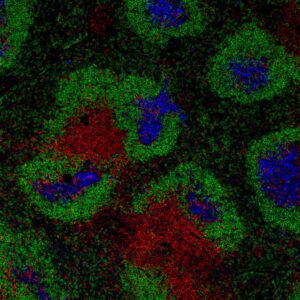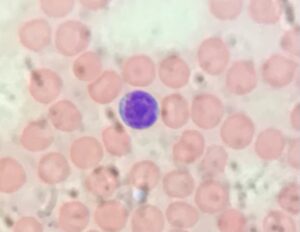More than ever, we are hearing about how important our immune system is to help us stay healthy. More specifically, a lot of attention has been given to a molecule called antibodies. Scientists are currently running against the clock to harbour the power of antibodies (amongst other immune tools) to design a good vaccine. But in order for us to understand why antibodies are so powerful at helping us fight infections, we first need to understand the basics. Shall we?
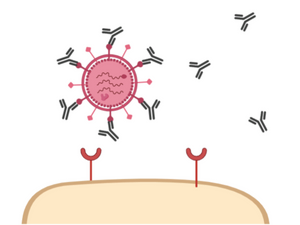
Created with Biorender
Antibodies: the basics
One of the beauties of our immune system is its ability to recognize microorganisms that cause diseases, which are known as pathogens. In order to do so, our immune system implements two layers of response: the innate and the adaptive immune response. Today, we will focus on the second layer. As I mentioned before, the adaptive immune system is composed of T and B cells. These cells are very specific to the pathogen to a single pathogen. Meaning that in your body you have T and B cells specific to influenza, T and B cells specific to SARS-CoV-2, etc.
What gives each cell its specificity, is a receptor which is expressed on its surface. These receptors are called the T cell receptor (TCR) and the B cell receptor (BCR), but if we are talking about antibodies, we just need to focus on one: the BCR. This is because antibodies are the secreted version of the B cell receptor, and their function is crucial during an immune response.
In order for us to understand why antibodies are so important, we need to analyze their structure!
Antibody structure: variable, but also constant
An antibody is usually shaped like the letter Y, and its structure can be divided into two regions: a variable and a constant region. The reason why we need both regions is very straightforward. I told you that each antibody is specific to a single pathogen, more specifically, to a small piece of a pathogen. Therefore we need a variable region, so each antibody will be able to bind to a different pathogen piece.
But what about the constant region? Well, antibodies perform very specific functions which occur when this molecule binds to other receptors. Therefore, we need to make sure that despite the antibody specificity, it will still be able to perform its function! Easy right? The variable region determines the specificity and the constant region allows for effector functions.
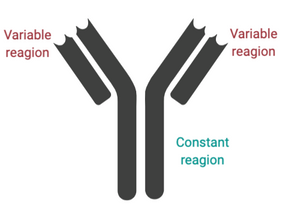
Representation of the structure of an antibody. Created with BioRender.
Antibody functions
Remember the last time you were infected with bacteria? Well, even if you don’t remember, chances are pretty high that your body was fighting a bacterial infection not too long ago. And if you somehow could look inside your body at the moment you are being infected, you would probably see the following. Get ready to be amazed!
Circulating in your blood, you have many, many different types of antibodies. These are specific to the pathogens you have encountered in your past. So, let’s imagine that you were already infected with bacteria x, and today, you were unlucky to be infected with it again.
This bacteria which is now present inside your body can be very detrimental to your health. However, since you have already been infected with bacteria x before, you have powerful tools (specific antibodies) that will help you take care of this issue.
These antibodies are specific to a piece of the bacteria x, and as soon as it encounters this structure the antibodies will bind (using its variable region). This will serve as a tag, which tells the immune system “hey, you need to remove this now!”. So the antibody, in this case, serves as an indicator to the immune system that this bacteria should be gone.
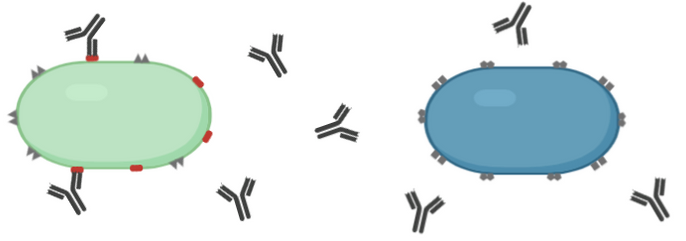
Representation of two bacteria types. Antibody molecules shown in black are only specific to the red structure of the green (left) bacteria. Created with BioRender.
Bacteria, and other microorganisms, which are coated with antibodies can be degraded by cells from our innate immune system. These cells have a receptor that is specific to the constant region of the antibody. Therefore the binding between receptor and antibody will alarm the immune cells of the current danger. Immune cells then “eat” the bacteria… I mean, perform phagocytosis… which will destroy this foreign invader! Smart, right?
Well, sometimes our immune system is not that smart. We can produce antibodies against unharmful things such as dust and pollen. You see where am I going with this? Allergy reactions can occur because our immune system, at one point, decided that pollen or dust molecules were VERY HARMFUL. By mounting an immune response and producing antibodies against these molecules, we now suffer from the effects of that mistake.
During an allergic reaction, the constant region of the antibody can bind to a receptor present on the surface of mast cells (which is an innate immune cell type). This interaction stimulates mast cells to secrete histamine, which leads to inflammation.
Antibodies and viral infection
But I think if you are reading this, you are probably trying to understand why antibodies are so important during viral infections. As I mentioned before, viruses are not considered living entities, therefore, it requires a home to “be alive”. But just like we need a key to enter our house, viruses also need to express such “key” to enter our cells. This is a crucial step to allow for viral entry. The binding of a viral protein to a cellular receptor.
Now, check this important point… our cells have not evolved to generate and express a specific receptor which would allow a virus to enter. These receptors have natural functions and are important to our cells, and that is why we express them. However, viruses have evolved to utilize these receptors for their own benefit. Very sneaky! So, when a viral protein (the key) binds to the cellular receptor (the lock), the virus will enter and infect our cells.
Our immune system, however, was VERY clever and designed a mechanism to cover the viral key. Yes, we can produce antibodies against the viral protein which is essential for viral entry. Once blocked, it can’t interact with the cellular receptor and therefore our cells can’t get infected. This trivial but beautifully engineered process is the gold mine to prevent viral infections.
And that is why you have been hearing a lot about antibodies lately. With the current pandemic, researchers are trying to develop vaccines that would have a goal (among many others) of triggering the generation of these antibodies, called neutralizing antibodies.
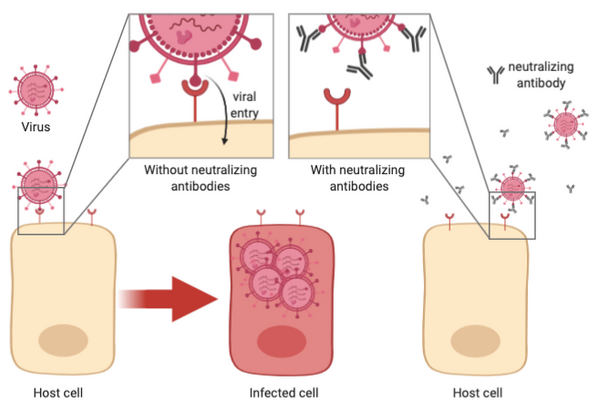
Neutralizing antibodies prevent viral entry. Created with BioRender.
Antibodies and Vaccine development
You might be thinking: “Ok Stefanie, I get it. But I think scientists are making this way too complicated. If we know the key (the viral protein), and we know we need a “covering” molecule (the neutralizing antibody), can’t we just inject people with such antibody?”
Well, this is a great idea! Lots of scientists are doing research in this area, with the exact thinking in mind! But here is the catch… every molecule is only functional for a period of time. Meaning that proteins pretty much have a “best before” date, and following that period of time they degrade.
The goal of a vaccine is to give you protection for a long period of time. So if you provide a molecule that can only live, let’s say… 3 months… it doesn’t sound too great, right? However, for some people (with an impaired immune system, for example) this approach can be powerful. Nevertheless, providing antibodies with the goal of long-term immunity for everyone doesn’t sound like a feasible vaccine approach.
So, what do we want? We want a vaccine that can lead to an immune response, that generates B cells able to produce neutralizing antibodies. Therefore even if our circulating antibodies are degraded, we will always have our “backup” B cells producing such proteins. Cool, right? While we wait and support research for the development of a vaccine, please stay safe and I will see you next week
From your immunologist – in training,
Stefanie Valbon

